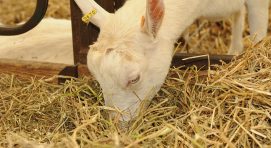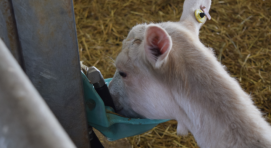How to know it’s there and what you can do about it
Sub-acute ruminal acidosis (SARA) is a well-recognized digestive disorder in dairy cow herds – but it’s one that can also affect dairy goats.
 In simple terms, acid levels in a goat’s gut can get too high when the animals consume diets high in fermentable carbohydrates and low in physically active fibre – too much grain and not enough forage – which disrupts feed fermentation in the rumen.
In simple terms, acid levels in a goat’s gut can get too high when the animals consume diets high in fermentable carbohydrates and low in physically active fibre – too much grain and not enough forage – which disrupts feed fermentation in the rumen.
According to Dr. Jocelyn Jansen, Veterinarian, Disease Prevention-Small Ruminant and Beef with the Ontario Ministry of Agriculture, Food and Rural Affairs, clinical signs of the disorder include going off feed, decreased milk production and/or diarrhea.
Symptoms can range from mild to severe, with goats reducing their feed intake for several days in order to reduce the acid load in their rumen and then starting to eat normally again, a cycle that can occur repeatedly if the grain to forage ratio in the ration continues to be out of balance.
Depressed butter fat levels are also a sign of SARA, but ruminant nutritionist Brian Tarr with Nutreco Canada says it is one that can go unnoticed in goats, particularly in the summer.
“Depressed butter fat is common in the summer so it is often just tolerated on the farm as long as goats don’t start to scour and die,” he explains, adding this means SARA is often not diagnosed as a root cause.
“It can be a very difficult thing to deal with on a typical goat operation. A doe might go off feed a bit but how do you spot one goat in a pen that is off feed?” he says. “What we often find is that we only really react when we see goats scouring and at risk of dying, and that’s when we see alarm bells going off.”
Once scours are present, milk production will drop and in serious cases, the doe will die. Animals that survive a bout of SARA often struggle to get their milk production back up to pre-illness levels.
Encouraging animals to increase forage uptake will drive butter fat production and encourage better rumen health, Tarr recommends.
“SARA affects most goat herds by some measure, especially in the summer. Once you have it, there are things that can help, it’s just a matter of how fast you identify it,” Tarr suggests, adding that the same measures will also help keep SARA at bay.
Cud-chewing
To help determine whether SARA might be an issue, Tarr advises taking a look at how many goats in the herd are chewing their cud at one time. This number will vary depending on the feed system used, but cud-chewing is an activity that is a sign of sufficient fibre in the diet, and fibre helps stabilize pH levels in the rumen. Feed particle size shouldn’t be too fine or too sloppy or wet, or it won’t provide for adequate cud-chewing.
Bunk space and bale feeders
Ensure there’s enough space at the feed bunk so all goats can access feed at the same time and rate. When it comes to forage consumption, bale feeders can pose a challenge for goats, animals that by their nature prefer to pick and sort their feed. They often can’t reach into the bale feeder for the forage material they’d like, but because the feeder still looks full of hay, new feed won’t be added.
“You could actually be making the problem worse by the way you feed your forage,” cautions Tarr, adding that proper forage management is important with goats.
“Some producers will feed goats the way we feed cows, once a day and hope for the best,” Tarr says. “But in the summer, where we struggle to keep forage intake up and get goats eating to get lots of cud-chewing, you need to feed fresh feed multiple times a day. There’s no way around that, and if you don’t, it affects the results you get.”
Clean water
Water intake drives feed intake and vice versa, making a very clean water supply in a clean bowl absolutely essential. Reduced water consumption leads to reduced forage intake, leaving goats to eat more grain, contributing to the potential for SARA.
 Minimizing heat stress
Minimizing heat stress
Tarr also recommends trying to keep heat stress to a minimum and keeping the animals as cool as possible on hot days so they’ll want to eat. Warm summer temperatures can be much harder on animals so it’s important to adjust
feeding management across seasons.
For more information, contact the Ontario Goat office at 1-866-311-6422 or info@livestockalliance.ca, or visit www.ontariogoat.ca.
